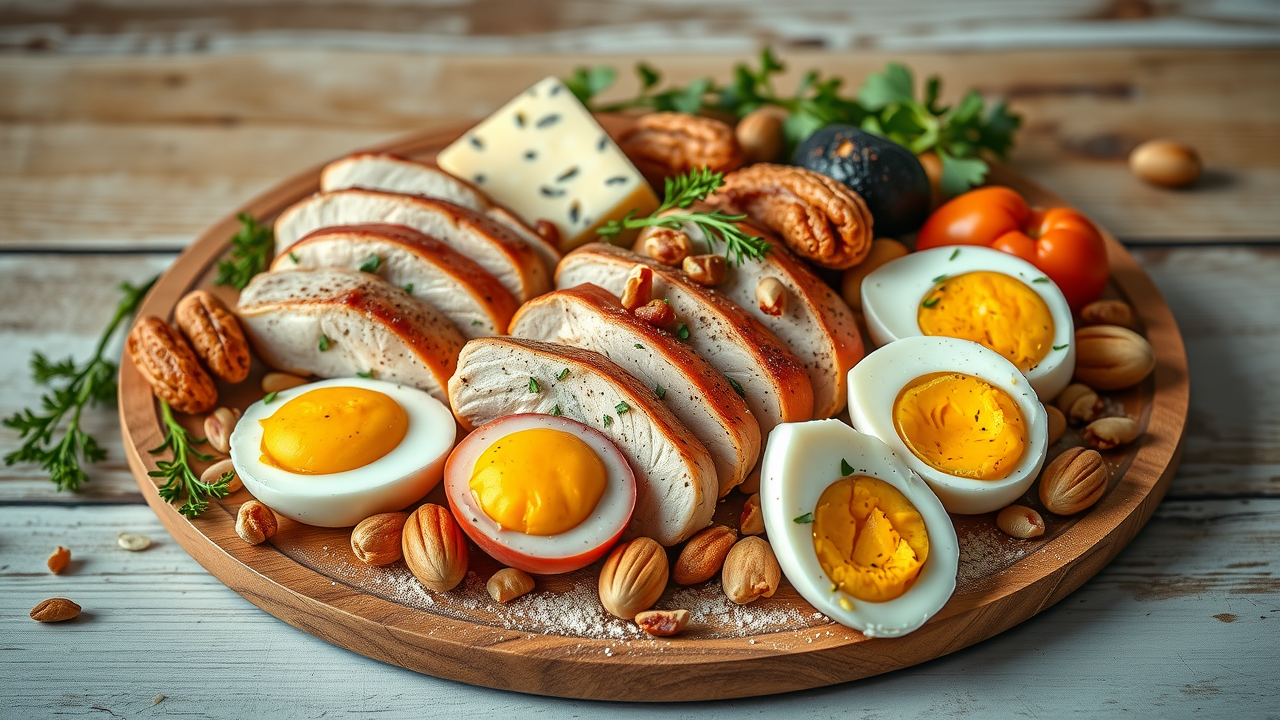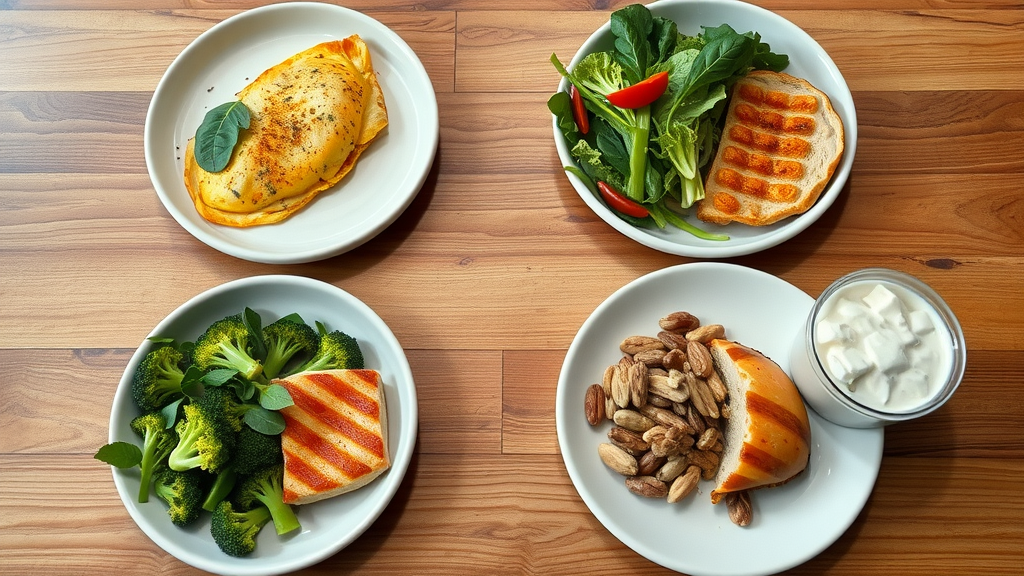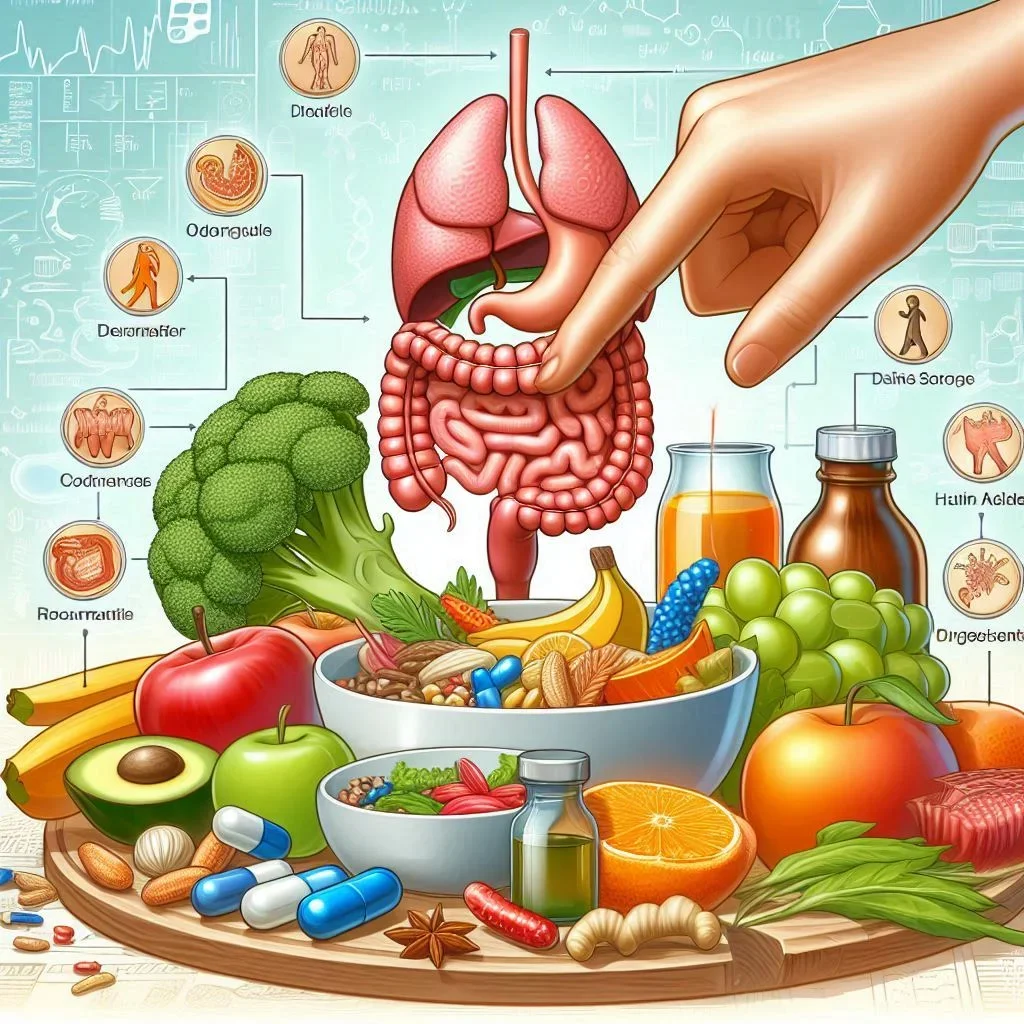Imagine waking up energized, craving nothing but wholesome food, and feeling satisfied all day. Starting a low-carb diet doesn’t have to mean hunger or frustration. If you want to know how to start a low-carb diet without feeling hungry, you’re in the right place.

This friendly, evidence-backed guide offers practical strategies—you’ll learn how to embrace low-carb living, build filling meals, and stay full, energized, and motivated from day one. Let’s start your journey to a more vibrant, satisfied you!
Embracing a Low-Carb Diet Without Hunger: The Energized Path Forward
Transitioning to a low carb diet often raises concerns about managing hunger and cravings effectively. But the secret to lasting success lies in the right approach from the start. With the proper strategies, you can experience days packed with energy—not frustration.
Choosing the right mix of high protein foods, healthy fats, and filling low carb foods helps keep you satisfied while supporting steady weight loss and overall wellbeing. In this section, we’ll explore practical, easily actionable steps so you never feel deprived. Whether you’re new to carb diets or seeking better results from your current meal plan, these insights will help you fuel your body and truly enjoy mealtime.
Understanding how to start a low-carb diet without feeling hungry involves not only what you eat but also when, how, and why you eat, which is essential for success on any low carb diet. The focus should be on building meals that keep you full, listening to your body’s real hunger cues, and making smart swaps for carb foods that truly satisfy. The energized path forward means replacing empty calories with real nourishment so you can thrive. Let’s start with a burst of inspiration!
Opening Inspiration: Imagine Your Best High-Energy Day
Visualize this: you wake up with vigor, stretch in the cozy golden sunlight of your kitchen, and whip up a delicious breakfast full of fresh eggs and colorful vegetables. Your body feels light, and your cravings are under control. Throughout your day, you navigate meals and snacks with steady focus and zero guilt—no uncontrollable urges for bread, pasta, or sugary treats. This is the life a low carb diet can help create.
On your best high-energy day, you make intentional food choices that keep your brain sharp and your body fueled. You enjoy hearty omelets or Greek yogurt in the morning, vibrant salads or grilled fish at lunch, and satisfying, protein-rich dinners that leave you content. And perhaps most importantly, hunger and mood swings are no longer an issue. The journey to living like this—full, happy, and healthy—begins with learning how to start a low-carb diet without feeling hungry.

Core Principles: How to Start a Low-Carb Diet Without Feeling Hungry
The foundation of a sustainable low carb diet lies in understanding the best low carb foods and habits that truly satisfy your appetite. Unlike restrictive diets that leave you starving, successful low-carb eating is about creating satiety through balanced, nutrient-dense foods—especially high protein sources and healthy fats. Fill your plate with eggs, lean meats, fish, cheeses, leafy greens, and healthy oils. Minimize starchy breads, pastas, and sugars, focusing instead on fiber-rich low carb vegetables and proteins that help you feel full for hours.
Another core principle of low carb diets is to be patient with your body as it adapts to using fat and protein as its primary energy source. Your metabolism will switch from relying on quick-burning carbs to using fat and protein as its main energy source. Drinking plenty of water, practicing mindful eating, and tuning into actual hunger—not boredom or stress—also help minimize hunger pangs. Most importantly, learning to meal plan and prep will set you up for low-carb success, making each week easier and more satisfying. Let’s break down the basics—why low carb works, how it compares to other diets, and the best food choices for you.
As you focus on building meals that keep you full and energized, incorporating creative, protein-rich snacks can make a big difference in your daily satisfaction. For a delicious and convenient option, consider trying Mediterranean egg bites, which offer a flavorful way to boost your protein intake while staying low in carbs. These types of snacks can help bridge the gap between meals and support your low-carb goals.
Understanding Low Carb and Carb Diet Basics
Before you jump in, it’s important to understand what sets a low carb diet apart from other carb diets and why it can be more effective for weight loss. Low carb focuses on reducing your carb intake—especially refined grains and sugars—while boosting protein and healthy fats. This change taps into your body’s fat reserves for energy and stabilizes blood sugar, promoting steady weight loss and increased energy. For anyone considering how to start a low-carb diet without feeling hungry, learning these basics helps simplify smart food decisions and avoid pitfalls.
Not all carb diets are created equal. Standard “carb diets” may center on grains, breads, and cereals—foods that spike energy briefly but often lead to more cravings later. In contrast, a well-structured low carbohydrate diet helps you feel full faster and longer, which is crucial if your goal is to lose weight sustainably. You don’t need to go to keto extremes—just prioritize whole, minimally processed foods that pack both nutrition and satisfaction.

What is a Low Carb Diet, and Why Should You Consider It?
A low carb diet is an eating approach that limits carbohydrates—mainly found in grains, starchy vegetables, sugary foods, and drinks—in favor of proteins and healthy fats. Most people start a low-carb plan to lose weight, improve metabolic health, or keep blood sugar steady. Clinical studies and the journal of clinical nutrition confirm that reducing carb intake can support steady fat loss, decrease hunger, and offer better energy throughout the day compared to high-carb eating.
Why should you consider a low carb diet? For many, the answer is simple: better appetite control and more predictable energy. By focusing on high protein foods and healthy fats, your body avoids the “sugar rollercoaster” typical of carb-heavy diets, leading to fewer crashes and cravings. Ultimately, learning how to start a low-carb diet without feeling hungry puts you in control of your hunger, weight, and overall health. It’s not about restriction, but making food choices that naturally satisfy—and truly fuel—you.
Carb Diets vs. Keto Diet: Key Differences
It’s easy to confuse low carb diets with the more extreme keto diet, but there are important distinctions. A standard carb diet can include 45–65% of daily calories from carbohydrates, including both refined grains and complex carbs. The keto diet, however, is a very low carb, high fat diet that triggers ketosis—a metabolic state where your body burns fat for energy instead of carbs. In between, a balanced low carbohydrate diet allows more carbohydrates than keto, but focuses on limiting processed foods, sweets, and starchy choices.
For most beginners, moderate low carb (30–100g carbs per day) is sustainable, providing flexibility and fewer side effects. Unlike the stricter ketogenic diet, you won’t necessarily limit yourself to high fat levels, but you will cut out carb foods that spike blood sugar. This helps you feel full on fewer calories and keeps you energized without constant cravings. Understanding these differences equips you to choose an approach that fits your goals and lifestyle.

Low Carb Food vs. Carb Foods: Making Smart Choices
Choosing low carb foods doesn’t have to be complicated when you focus on nutrient-dense options that help you feel full and energized. Start by filling your grocery cart and plate with foods that are naturally low in starches and sugars: eggs, non-starchy vegetables (leafy greens, cauliflower, broccoli), lean meats, fish, nuts, seeds, and select dairy products like Greek yogurt or cheese. Compared to carb foods—think potatoes, pasta, pastries, and sugary drinks—these options help you feel full and energized without spikes and crashes.
Smart swaps are key. For example, replace rice with cauliflower “rice,” use spiralized zucchini noodles instead of spaghetti, and reach for nuts or hard-boiled eggs as snacks instead of crackers. The next time you make a meal plan, focus on well-rounded plates that include protein, fat, and fiber—while keeping carb intake in check. These strategies not only support your weight loss goals but also help manage cravings and encourage healthier long-term habits.
Why Am I So Hungry When I Start Low-Carb? (People Also Ask)
It’s common to feel hungrier than usual when you first cut carb foods, but this is a normal part of the low carb diet adaptation period. This transition is your body adjusting to a new primary energy source. Those initial few days—sometimes up to a week—can bring extra cravings, especially if you used to rely on carb-rich snacks for quick satisfaction. But there’s good news: your appetite almost always normalizes as your body adapts to using protein and fat for fuel. If you’re wondering how to start a low-carb diet without feeling hungry, acknowledging this adjustment period is crucial.
During this phase, it’s important to avoid under-eating. Instead, focus on eating plenty of high protein foods and healthy fats at every meal. Drink water regularly, and try to include fiber from low carb vegetables to support both digestion and fullness. Remember, true hunger should be addressed—not ignored. Learning to satisfy cravings with smart, filling choices is key to making your low carb journey smooth and sustainable.
Addressing Initial Hunger and Cravings on Low Carb Diets
The discomfort of initial hunger often fades quickly, but successful adaptation depends on supporting your body with the right foods. The urge to snack on carb foods can be strong, but it’s more about habit than true hunger. High protein foods—like chicken, eggs, or Greek yogurt—help you feel full because they take longer to digest and support balanced blood sugar. Adding healthy fats such as avocado or olive oil further curbs appetite and increases satisfaction from each meal.
Most experts recommend eating to fullness (not to the point of discomfort) during your first week on a low carbohydrate diet, rather than slashing calories too fast. This gives your metabolism time to recalibrate and helps reduce cravings for sugary foods.
Drink plenty of water several times a day (sometimes thirst masquerades as hunger), and try to maintain a consistent meal schedule to keep your metabolism steady and your moods even. You’ll be amazed at how quickly your appetite resets and your energy improves.
How to Reduce Hunger When Starting a Low-Carb Diet
How to Eat Low-Carb and Not Be Hungry? (People Also Ask)
The key to eating low carb without being hungry is focusing on high protein foods, healthy fats, and fiber-rich low carb foods that provide maximum satiety per calorie. You’ll want to include a combination of high protein foods, healthy fats, and fiber-rich vegetables in each meal.
This trio helps you digest meals slowly, maintain full feeling for hours, and prevents the blood sugar crashes that drive snacking. Practical meal planning, ingredient awareness, and a little creativity ensure you’re never stuck with bland or boring food.
Try to avoid common mistakes like skipping meals or cutting calories too rapidly, as this often backfires by increasing cravings. Instead, start your day with a protein-rich breakfast, carry easy snacks (like cheese, nuts, or hard-boiled eggs), and fill your plate with low carb vegetables at lunch and dinner for bulk and nutrients. If you’re mindful of portions and texture variety, you’ll enjoy each meal—and stay satisfied while you lose weight the healthy way.
Satiety Secrets: Proteins, Fats, and High Protein Low Carb Foods
Research shows that high protein diets are especially effective for appetite control and long-term weight loss. Protein-rich foods—chicken breast, fish, tofu, eggs, Greek yogurt, and lean meats—are more filling than simple carbs. Healthy fats (avocado, olive oil, nuts, seeds) add flavor and slow digestion, keeping you full for hours. Building meals around these foods ensures you maintain steady energy and avoid those dreaded hunger pangs.
Great low carb food combinations include eggs with sautéed spinach, grilled salmon with asparagus, or cottage cheese with berries and nuts. Non-starchy vegetables add fiber, which increases meal volume and extends fullness. Remember, variety is your friend—mix up proteins, try different healthy fats, and experiment with herbs and spices to keep meals exciting. These small adjustments make all the difference in helping you feel full and energized as you adjust to a low carb diet.

How Do You Start a Low Carb Diet for Beginners? (People Also Ask & Step-By-Step)
If you’re new and want to know how to start a low-carb diet without feeling hungry, begin with gradual swaps of carb foods for high protein and low carb foods, focusing on simple, unprocessed ingredients. Don’t try to overhaul everything overnight—instead, replace carb-heavy sides with double portions of vegetables or a protein-based snack. Plan for 3 main meals and 1-2 snacks each day to avoid dips in energy and mood. Prioritizing high protein helps you feel full and reduces your cravings for sugar and starches.
Clear out your pantry of obvious carb foods such as white bread, cookies, rice, and breakfast cereals. Shop for lean meats, fish, eggs, leafy greens, nuts, and seeds. Remember, hydration is as crucial as food selection—often, the body confuses thirst with hunger, especially in the first week of changing your meal plan. Stick with the plan, and your new eating habits will soon become second nature—bringing steady energy, clearer thinking, and fewer cravings with every passing day.
Beginner-Friendly Tips to Start a Low-Carb Diet Without Feeling Hungry
Start with one meal at a time, making simple substitutions—swap out toast for an omelet, pasta for zucchini noodles, or chips for nuts. Fill at least half your plate with non-starchy vegetables. Prepare snacks that include protein and fat, such as cheese cubes, hard-boiled eggs, or celery with peanut butter. Check nutrition labels to identify hidden sugars and excess starches. Rely on weekly meal plans so you never have to guess what’s next at lunch or dinner.
Listening to your real hunger cues is vital. Eat slowly, chew mindfully, and stop when you’re satisfied (not stuffed). Hydrate generously, and remember—caffeine or sweetened drinks won’t curb real hunger. Give yourself time to adapt. The first week is the toughest, but with these strategies, you’ll set yourself up for success and confidently learn how to start a low-carb diet without feeling hungry.

Meal Plan Strategies for Low Carb Diet Success
Planning ahead is your best defense against last-minute cravings and drive-thru temptation. Start with a simple weekly meal plan that includes a variety of high protein mains and satisfying sides. Think baked salmon and leafy greens, turkey burgers with roasted cauliflower, or stir-fried tofu with colorful veggies. Having wholesome options at the ready means you never have to reach for quick carb foods or feel deprived.
Batch-cook proteins and prep vegetables at the start of the week. Stock your fridge with easy-to-grab snacks—like Greek yogurt, boiled eggs, or cheese sticks. Rotate recipes to keep things fresh and adjust your meal plan based on what satisfies you most. Remember, the key is to be flexible: swap ingredients, adjust portion sizes for your hunger, and celebrate every win along the way. These strategies make starting (and sticking to) a low carb diet not just possible, but truly enjoyable.
Building Balanced Meals with High Protein and Low Carb Foods
The heart of a filling, energizing low carb meal is a solid source of protein complemented by vegetables and healthy fats. For example, breakfast could be scrambled eggs with spinach and tomato; lunch, a grilled chicken salad drizzled with olive oil; dinner, baked cod with roasted broccoli and a handful of walnuts. Snacks should combine protein and fat—think cottage cheese and berries, or a handful of mixed nuts—to keep you full until your next meal.
Keep your meals visually satisfying and colorful. Add fresh herbs, lemon, or spices for flavor without excess carbs. Choose low carb foods like zucchini, leafy greens, cauliflower, and peppers, and vary your protein sources to avoid taste fatigue. You’ll not only feel full, but you’ll also get lasting enjoyment from your new, healthier eating routine.
How Long Does It Take for the Body to Adjust to a Low Carb Diet? (People Also Ask)
For most people, the body takes between one to two weeks to fully adjust to a low carb diet. During this adaptation period, it’s common to feel a bit more hungry or tired as your metabolism shifts from burning glucose (from carbs) to utilizing fat and protein as its main energy source. Once you’ve adapted, your appetite usually stabilizes and your energy increases—making it easier to lose weight and maintain your new habits.
Stay patient. Drinking water, ensuring adequate salt intake (to avoid feeling sluggish), and choosing nutrient-dense high protein foods helps support your transition. If you do experience cravings, address them with a wholesome snack rather than slipping back into old patterns. Each individual’s journey is a bit different, but commitment and planning pay off quickly in steady moods, better digestion, and lasting satisfaction from meals.
Adaptation Period: What to Expect When You Reduce Carb Foods
The initial days of cutting carb foods can bring about cravings, headaches, or moodiness—sometimes called the “carb flu.” These symptoms are temporary and often pass within a week or two. Your body is adjusting to using fats and proteins more efficiently, which means hunger cues shift and you may experience different energy patterns. Support your body by maintaining a regular sleep schedule and getting gentle exercise like walks or stretching, which can also help curb cravings.
It’s normal to wonder if you’re on the right track. Know that with every healthy meal you eat, you’re training your metabolism for lasting wellness and confidence. Hydrate, eat to fullness, and don’t be afraid to experiment with meal plans until you find what works for you. The biggest reward? Enjoying low carb foods that keep you full while watching your cravings and extra weight melt away—one day at a time.

Essential Tips: How to Start a Low-Carb Diet Without Feeling Hungry
Prioritize high protein foods and healthy fats
Snack smart with nutrient-rich low carb foods
Stay hydrated
Include plenty of low carb vegetables
Listen to your body’s hunger and fullness signals
Applying these tips is a sure way to feel full and confident as you begin your low carb journey. Focus on meals and snacks that combine protein and fat, drink water regularly, and choose low carb foods that nourish your body and keep cravings in check. Pay close attention to hunger cues and meal satisfaction to ensure you’re never left feeling deprived.
Preparation, awareness, and flexibility are your secret weapons. With planning and a bit of practice, you’ll master how to start a low-carb diet without feeling hungry—and you just might find yourself loving every meal!
Creating Your Low Carb Diet Meal Plan and Food List
One of the best ways to keep hunger at bay is to design a targeted meal plan centered on high protein and low carb foods. Having a go-to food list on hand makes grocery shopping and cooking easier—and removes the temptation to fall back on higher-carb choices. Start with breakfasts that hold you over (omelets, Greek yogurt, cottage cheese), lunches featuring lean proteins and veggies, and dinners heavy on satisfying mains with plenty of flavor.
Your food list should include a rotation of proteins, non-starchy vegetables, healthy fats, and quick-to-prepare snacks. Planning keeps your day on track and makes it simple to lose weight without feeling deprived. Below are sample meal ideas and a handy, hunger-curbing food list to get started.
Sample Low Carb Diet Meal Plan: Breakfast, Lunch, Dinner, Snacks
Breakfast: Vegetable omelet (eggs with spinach, tomato, and feta) or Greek yogurt with nuts and a few berries.
Lunch: Grilled salmon salad (mixed greens, cucumber, avocado, and olive oil drizzle) or turkey lettuce wraps.
Dinner: Roasted chicken with broccoli and cauliflower or beef stir-fry with peppers and mushrooms.
Snacks: Hard-boiled eggs, cheese sticks, almonds, or Greek yogurt.
Variety is key for both satisfaction and filling your nutrient needs. Swap in different proteins, leafy greens, and flavorings each week. Build your meal plan by mixing and matching these staples—and always keep smart snacks on hand to crush any cravings between meals.

List of High Protein, Low Carb Foods to Keep You Full
Eggs
Lean meats (chicken, turkey, beef)
Fish and seafood
Greek yogurt
Tofu and tempeh
Low carb vegetables (spinach, kale, broccoli)
Cheese and nuts
These foods form the backbone of a delicious and satisfying low carb diet. Use them to build delicious meal plans that help you feel full and energized all day. Keep a mix of these options on hand for quick meals or snacks—the more variety you have, the less likely you are to get bored or experience cravings.
Common Challenges with Low Carb Diets and Effective Solutions
Even the most experienced dieters encounter occasional challenges when reducing carbs. The most common issues include ongoing hunger, cravings for old favorite carb foods, low energy, or boredom with meal plans. Don’t let these obstacles derail your progress—effective solutions and support make all the difference. Addressing these challenges head-on will keep you on track and loving your new healthy approach to food.
Revisit and refresh your food list every couple of weeks. Try new recipes, get creative with seasonings, and switch up your snack options. Lean on friends, family, or online communities for encouragement, and don’t be afraid to ask for help when needed. Each challenge is an opportunity to learn and build lasting habits!
Managing Hunger and Cravings While Losing Weight
To minimize hunger and manage cravings, never let yourself get too hungry: schedule meals and snacks, and always keep high protein foods available. Stay mindful about emotional triggers—stress, boredom, and fatigue can lead to mindless eating. Combat these by drinking water, taking a walk, or practicing deep breathing. Satisfying cravings with nutritious low carb substitutions—such as baked cheese crisps or almond flour muffins—can help keep your journey enjoyable and sustainable.
Tracking your meals and feelings can reveal patterns and help you address hunger proactively. Slow weight loss is often more sustainable than fast drops, so focus on progress—not perfection. Remember, smart meal planning, regular hydration, and prioritizing protein and fiber are the best ways to stay in control and happily lose weight with fewer setbacks and more satisfaction.
Staying Motivated Through the Low Carb Diet Journey
Motivation ebbs and flows, especially as your body and mind adjust to new habits. Celebrate the small wins: a week without cravings, increased energy, or fitting comfortably in your clothes. Set realistic, achievable goals and remind yourself of your “why”—whether that’s better weight loss, higher energy, or improved health markers.
Find a buddy to share progress and recipes with, join an online group, or journal about your journey for added accountability. Remember, everyone experiences ups and downs. The important thing is to stay kind to yourself, adapt when needed, and acknowledge that building new habits is a process—not an overnight fix. Every positive change you make contributes to your long-term health and success with a low carb diet.
Tips on Low Carb Diets and Hunger
Starting a low-carb diet isn’t about restriction, it’s about satisfaction through better food choices.
Choose nutrient-dense, high protein foods to naturally curb hunger and stay energized.

FAQs on How to Start a Low-Carb Diet Without Feeling Hungry
Can you lose weight on a low carb diet without being hungry?
Yes! Most people can lose weight on a low carb diet while minimizing hunger by focusing on high protein foods, healthy fats, and fiber-rich vegetables. These foods promote satiety, regulate blood sugar, and help you feel full for hours. Pair this with proper hydration and mindful eating, and you’ll shed pounds without the discomfort of constant cravings.
What are the best high protein foods for low carb diets?
The top high protein foods for low carb diets include eggs, lean poultry (chicken, turkey), fish and seafood, Greek yogurt, cottage cheese, tofu, tempeh, and select cheeses. These foods offer robust nutrition and, when paired with low carb vegetables like spinach or broccoli, deliver satisfying, well-rounded meals to keep you full and energized throughout the day.
Are low carb diets safe for everyone?
Most healthy adults can safely start a low carb diet. However, those with certain health conditions (such as diabetes, kidney disease, or heart problems) should consult a healthcare professional first. Pregnant or nursing women, or those on specific medications, may need to individualize their carb intake or dietary plans to ensure safety and proper nutrition.
Conclusion: Start a Low-Carb Diet Without Feeling Hungry—Take the First Step Today
With knowledge, planning, and delicious high protein meals, you can start a low-carb diet without feeling hungry—so begin your energized journey to feeling satisfied every day!
If you’re inspired to take your healthy lifestyle even further, consider exploring how nutrition can impact your overall well-being beyond weight loss. Discovering which foods can help combat chronic conditions like cancer and diabetes can empower you to make even more informed choices for lifelong vitality. By understanding the broader benefits of a nutrient-rich diet, you’ll unlock new strategies for health, prevention, and energy—making your low-carb journey just the beginning of a truly transformative wellness path.
Sources
National Institutes of Health – Clinical Effects of Low-Carbohydrate Diets
Academy of Nutrition and Dietetics – Low-Carb Diets for Weight Loss
Embarking on a low-carb diet without experiencing hunger is achievable by implementing effective strategies. The article “Low-carb eating made easy: how to beat hunger” offers practical tips such as prioritizing protein intake, incorporating non-starchy vegetables, and choosing healthy fats to enhance satiety. (rosycheeked.com)
Additionally, “Losing Weight Without Feeling Hungry: Eight Tips” emphasizes the importance of hydration, consuming fiber-rich foods, and including whole grains to manage hunger effectively. (diabetesselfmanagement.com) By integrating these approaches, you can maintain a satisfying and sustainable low-carb lifestyle.
For More Great Articles and Videos on Weight Loss, CLICK HERE
 Add Row
Add Row  Add
Add 




Write A Comment